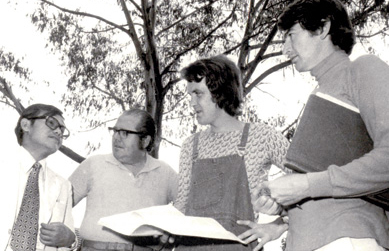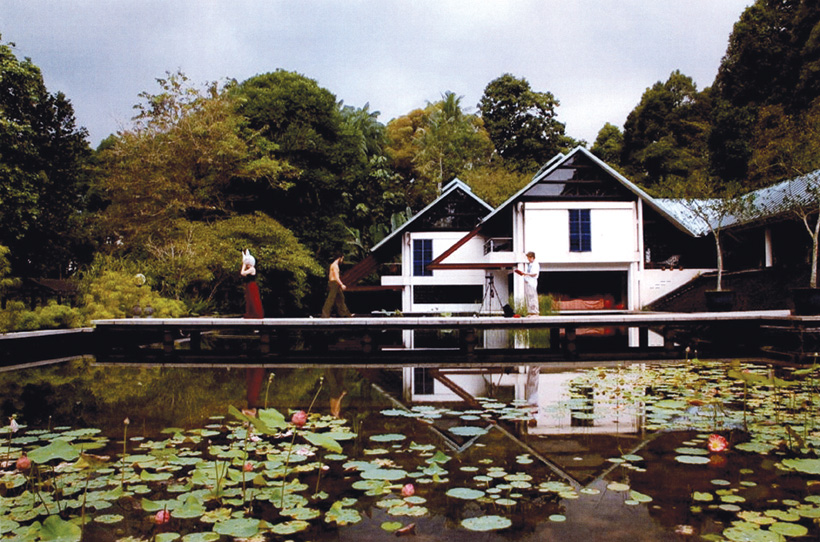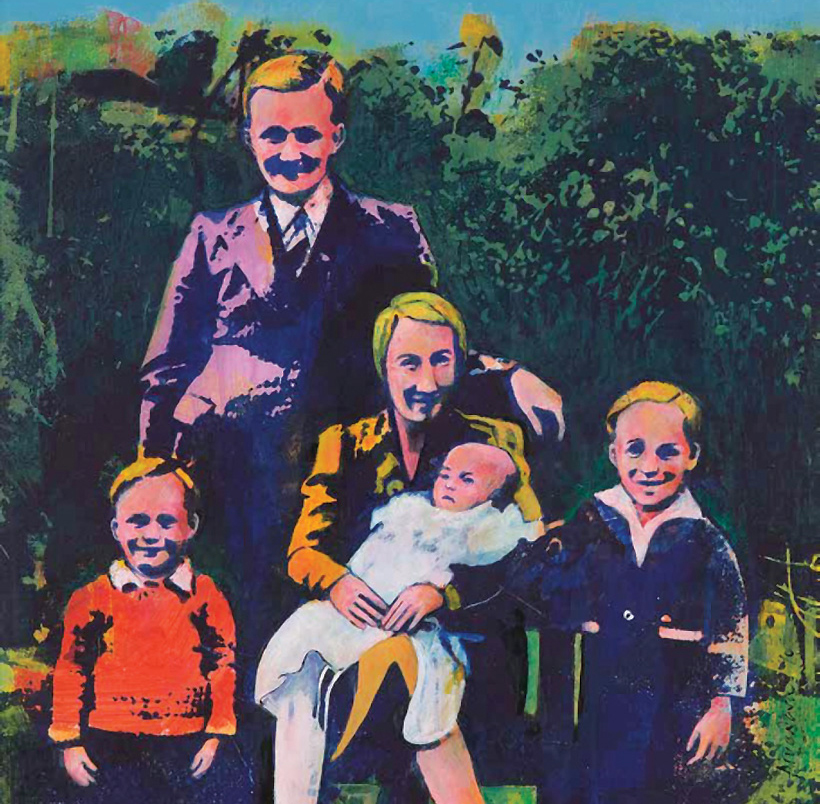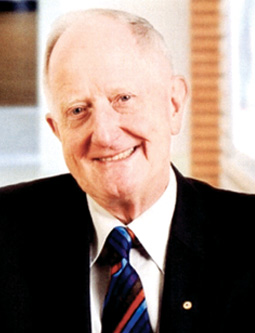Chapter 4
A Vibrant Tradition of Artistic Exchange
Nurturing the arts
One memorable pioneer of the arts in Malaysia was Frank Sullivan, the Australian Press Secretary to Malaysian Prime Minister Tunku Abdul Rahman. Sullivan had a close, lifelong association with Malaysia that began during the Pacific War. He purchased his first painting in Singapore in 1946 and became so intrigued by the art of Malaya that, in 1952, he co-founded the Malayan Arts Council (MAC). In 1956, just prior to independence, the MAC successfully broached the idea of a National Art Gallery with the Tunku. Such was the Tunku's support for the gallery, it opened in 1958 in his residence where it remained until moving to its current location in 1984. Sullivan was indefatigable in the realisation and promotion of the gallery, as Secretary of the first Working Committee and then as a member of the Board of Trustees, a position he held until 1971.
Further promoting modern Malaysian artists, Frank Sullivan opened the Samat Gallery, Malaysia's first commercial gallery for contemporary art in 1967 with the support of Tan Sri PG Lim, distinguished lawyer, Malaysia's first female diplomat and fellow patron of the arts.28 This spirit of artistic partnership has been sustained over the 60 years of our diplomatic engagement. Many Australians, like Sullivan, have contributed to a reputation for promoting and supporting Malaysian culture and the arts and, as Neil Manton, former diplomat and connoisseur of Southeast Asian art, recounts, the Australian High Commission was at the centre of this activity.
Australian paintings went on display for the first time at the High Commission in November 1960, when Tom Critchley was High Commissioner, attracting distinguished guests including the Yang di Pertuan Agong and the Raja Permaisuri Agong. There were 16 paintings on display by some of Australia's most celebrated artists, including Sidney Nolan, Russell Drysdale, Lawrence Daws, Kenneth Jack, John Brack and Robert Dickerson, with Nolan's iconic 'Ned Kelly, Outlaw' attracting much attention.29 Malaysian art first went on display in Australia in Sydney in 1965 and, in 1969, the first touring exhibition of Malaysian art travelled to Australia and New Zealand. Fifty artists were included, introducing Australians to the traditional art of the wayang kulit— the epic plays of the Ramayana and Mahabharata—through to the most modern and adventurous painters of Malaysia's flourishing 1960s art scene.
There have since been many opportunities for Australians from every part of the country to appreciate Malaysian art. In 1999, for example, a special artistic collaboration was undertaken when Country Arts SA and the National Art Gallery of Malaysia brought artists from the remote Anangu Pitjantjatjara Yankunytjatjara region of South Australia30 together with artists from Sabah and Sarawak in East Malaysia. The results of their exchange of ideas around 'the land, how we use it, [and] how we come to know it' was exhibited around South Australia and Malaysia in 2000 and 2001.31 More recently in 2014, the 'Arts Kuala Lumpur—Melbourne' exhibition displayed the work of 15 renowned Malaysian artists in the heart of Melbourne and in 2015, an exhibition of Southeast Asian art at the Australian National University's School of Art Gallery featured a significant body of work by some of Malaysia's best known artists.
'Lavishing culture on Malaysia'
Cultural curiosity was an enduring theme at the Australian High Commission on Jalan Yap Kwan Seng in the 1980s and 1990s. In reporting on the multiple visual exhibitions, seminars on playwriting, and musical performances being held in 1994, The Canberra Times effused 'Australia lavishes cultureon Malaysia'.32 That year the High Commission hosted Malaysia's first Fringe Festival—named 'Do You Like My Fringe?'—featuring drama workshops and plays. It was also reported that the National Language Authority of Malaysia had initiated the translation of Australia's Blinky Bill children's stories for screening on Malaysian television.33
The 1990s was an inspired decade for the arts. In 1991, Asialink sent its first artists to Malaysia under its Arts Residencies program. It has since facilitated over 45 artist residencies across Malaysia—from Kuala Lumpur to Kuching— with considerable support from the AMI, the High Commission, and many arts bodies in Australia and Malaysia.34 A rich diversity of artists have sought inspiration from Malaysia—sculptors and jewellers, architects and theatre directors, poets and playwrights, jazz and opera singers.
These burgeoning ties have continued in the 21st Century. In 2015, two artists were selected for the Malaysian Arts Residency. Suzanne Howard, an interdisciplinary artist, went to Cherrycake Studios in George Town to develop 'large-scale video installations exploring place, architecture and cultural traditions' and Omar Musa, a Malaysian–Australian author and poet, splitting his residency between Rimbun Dahan in Kuang and Hotel Penaga in George Town, worked on a novel combining 'Malay myths and ghost stories with hard-edged observations of politics, gender, history and religion'.35
Rimbun Dahan and the heritage arts Hotel Penaga form part of the Hijjas family's arts residencies program in Malaysia. In parallel with Asialink, these began in 1994. Hijjas Kasturi, architect and conservationist, studied in Australia as a Colombo Plan student in 1958. The arts residencies, he says, are 'his way of paying something back to both countries'.36 He and his Australian wife Angela support Australian and Malaysian artists to develop and exhibit their work. Australian artists spend a year-long residency at Rimbun Dahan which, as well as being the Hijjas family home, is a centre for developing traditional and contemporary art forms.37 The centre is also home to a permanent collection made up entirely of works by former resident artists. To complete the two-way exchange, the Hijjas family is developing a site in Horsham, in the Wimmera region of Victoria, where Malaysian artists will spend three months submerged in their artistic practice.38
Exciting collaborations continue to be forged between artistic communities in Australia and Malaysia. In August 2015, the George Town Festival and the Adelaide OzAsia Festival signed an MOU to collaborate over three years. In the same month, Australian artist Abdul-Rahman Abdullah participated in a two-week residency program at Gallery Petronas in Malaysia as part of a twoway exchange with the Islamic Museum of Australia.


My Story

Painting by Malaysian artist Redza Piyadasa, entitled Neil's Family (1990).
Celebrating years of artistic collaborations
In the 1980s, the Australian High Commission on Jalan Yap Kwan Seng—despite its concrete austerity—had one of the best exhibition spaces in Malaysia.
In 2002, the High Commission produced a publication, menjejak kembali, which recorded the major exhibitors of the previous twenty-year period. The compilation is a valuable record of Australia's involvement with Malaysia and its people at a very human level—an intimate cultural engagement which underpinned the overall bilateral relationship. Many of the artists who exhibited at the High Commission are among Malaysia's most important—Latiff Mohidin, Fauzan Omar, Khalil Ibrahim, Sharifa Fatima Syed Zubir, Tan Choon Ghee, Yeoh Jin Leng, Suleiman Esa, Long Thien Shih, Chang Fee Ming, Chew Fang Chin, Tajuddin Ismail, Yusof Ghani, Zeng Yuande and Anurendra Jegadeva.
Over the years, Australia hosted artists from all over Malaysia. There was a magnificent exhibition of Iban weaving from Sarawak which featured dancing and a demonstration by a weaver who produced a wonderful textile sitting on the floor in the High Commission's reception area. Then there were the exhibitions from groups such as the Malaysian Watercolour Society, the Malaysian Artists Association and the Utara Group. These 'shows' drew a wide audience so the impact the High Commission had locally was greater and the publicity was a valuable tool in our public diplomacy efforts.
Opening nights were wonderfully bright occasions with batiks and colourful silks lighting up the evening and animated conversations filling the space as we viewed the works on display and talked with the artists themselves. Press coverage was good with the High Commission praised for its support of local cultural product and producers.
As part of an exhibition we also hosted artist talks and opened on the weekends so that school groups might come in to engage with the artists and the paintings. Particularly rewarding was that most exhibitions would be opened by local dignitaries up to Cabinet Minister level, which gave staff opportunities for informal political contact. Such was the High Commission's profile for its support for Malaysian art that even in difficult political times, Ministers still came to perform the opening ceremony.
The High Commission also played host to Australian touring exhibitions. One such exhibition was by Melbourne-based artist Yao Di-Xiong, whose 100 metre long painting, 'Hundred Kangaroos' (seratus kanggaru), was painted on panels. I was astonished on meeting him at the airport to find all the panels rolled up and stowed in one big bag which we lugged back to the High Commission before getting a small army of volunteers to blu-tack them on the walls. The effect was wonderful until the air conditioners were turned on the next morning blowing most of the panels on the floor! More blu-tack needed!
A feature of this visit was Yao's workshops with local artists which were highly successful cultural exchanges. I will never forget the scene in our space with dozens of artists dashing off quick images of local birds and animals, trees and shrubs in Chinese ink. Yao's exchange was repeated in Sarawak with local artists and an enthusiastic audience, delighted at his efforts to paint the local native symbol, the kenyalang or hornbill.
During my time in Kuala Lumpur I felt that these personal exchanges were the most important feature of the High Commission's public diplomacy program. Such exchanges led to long-term friendships and a continued cross-cultural understanding. I am very pleased that, though the High Commission is no longer home to those art exhibitions, artist-in-residence programs are strongly promoted by the Department of Foreign Affairs and Trade through Asialink. Our diplomatic commitments continue to strengthen our relations with a valued neighbour in Southeast Asia.
My Story

Architect and Planner Cox Architecture
Malaysia has emerged in Southeast Asia as one of the most progressive nations with close ties to Australia particularly in education and service industries.
As an emerging nation on the most southern tip of the great Eurasia land mass, it represents unlimited opportunities–culturally, politically and economically. It is only in recent times that Australia has seen itself as part of Southeast Asia and as a consequence there is an increasing exchange between the two nations.
We were involved in the early planning of Iskandar in Johor, master-planning the second crossing and establishing urban development between the two links. This was mainly under the direction of UEM and Renong and has proved to be of great success and now part of Pemandu, the Malaysian Government economic plan for Malaysia in the development of Iskandar.
I have had the experience of being on the Board of UEM Sunrise Berhad, substantially owned by Khazanah, and involved in the investment and the development of property throughout Malaysia, Canada, Australia and South Africa. Working mainly as a consulting architect and planner in Malaysia we have worked with some of the most important companies, including IOI Group, Kuala Lumpur Kepong Berhad, Sime Darby and many others in planning and development in Malaysia.
We were also involved in designing the KLCC Convention and Exhibition Centre, its twin towers providing a centrepiece for central Kuala Lumpur. Most recently, planning Kuching and the northern expansion of the city and parliamentary zone has been exciting, as has the planning of the Sibu Waterfront.
Working with Malaysians has been an enjoyable experience, especially in our cultural interchange. Malaysia possesses such a rich heritage in the visual and performing arts that provide a source of fascination to Australians. Australian culture, although relatively new, can return with a vigour and different interpretation and inspiration of western culture that is appealing.
With common language and early Colonial British history there remain common bonds that provide cultural and planning strategies for both countries to explore and develop.
Our stories on film
Although interactions in filmmaking have been modest, our efforts to share our stories through film go back to the 1950s. In 1956, Australian High Commissioner Critchley presented the Federation of Malaya with a batch of Australian films, bringing the collection held in Malaya to 170 films made by the Australian News and Information Bureau. The bureau had been created in 1950, primarily to promote Australia to potential migrants after the war, but it also played an important role acquainting post-colonial Asia with Australia. The films were loaned to students free of charge, but were also included in the repertoire of the Malayan Department of Information's mobile cinema service. It was estimated that the 93 mobile cinemas reached an audience exceeding 10 million each year.39
From those humble beginnings, our cinematic connection entered new and exciting territory in 2014, when Malaysia joined a growing network of countries hosting the Tropfest Short Film Festival—the world's largest short film festival. Tropfest began modestly in a Sydney café in 1993 as an avenue for small budget films 'about our stories for our people', opening filmmaking up to anyone with a story and a camera. The managing director of Tropfest Southeast Asia, Joe Sidek, is also director of the George Town Festival in Penang.40
My Story

My love affair with Australia started some 45 years ago when as a poor kampung boy I was given the chance to study in Australia for free. I jumped at the opportunity. With the meagre savings from my parents and the proceeds of their pawned wedding rings and jewellery, I embarked on the journey of a lifetime. Australia delivered on its promise, and more. It gave me through education a ticket to a better life, one that I could only have dreamt about, and friendships which have lasted a lifetime.
There was the lecturer who offered a helping hand with assignments and made me a part of his family. Another kindly offered me longer exam times because of my poor command of English (I declined). Most of all I remember the love of my adopted 'Aussie Mum', Mrs Joan Buchanan. I was welcomed into her home and raised as the 'fourth son'. I remember fondly the bland 'meat and three veg' meals and 'fish and the same three veg' on Fridays. How things in Australia have changed! Many of us who studied in Australia in the sixties and seventies still remember those wonderful Australians who played such important roles in our lives. Those unsung heroes and heroines were instrumental in laying the foundation of our 60 year strong bilateral relationship.
Seventeen years ago, I jumped at the opportunity to repay the kindness of Australia and my alma mater Swinburne University when I was approached to help establish Swinburne University in my adopted hometown of Kuching. Today, it is a thriving university with 4000 students from 60 countries, all of whom will graduate with an Australian quality education.
It has been an honour to serve Australia as the Honorary Consul in Kuching for the last 24 years. A role I find very fulfilling as it gives me the opportunity to provide assistance to Australians living in or passing through Sarawak. Extending a helping hand to Australians in need is my way of repaying Australia for the love and helping hand I received some 45 years ago.